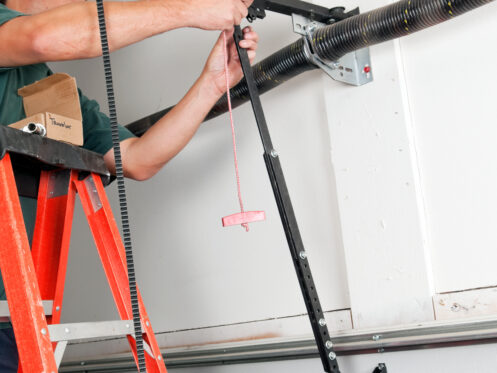Garage doors can play a huge role in daily routines. According to the American Housing Survey, up to 80% of households have a garage, and the average garage door opens or closes three to five times each day. That translates into 1,500 garage door openings each year. Given this constant activity, it is easy to see how the garage door’s components may experience more than their fair share of wear and tear. One such component is the garage door spring. The spring provides the mechanism by which your door opens or closes smoothly. There are two types of springs: torsion springs, which wind and unwind to help open the door, and extension springs, which lengthen to help open the door. But what are the signs that the door spring needs extra attention? Here is a look at the top indicators that it is time to get help for your door spring, which can, in turn, help ensure that your garage door remains in excellent working condition.
1. Loose Cables
The garage door spring works in conjunction with cables to help lift and lower the door. Often when homeowners believe their cables are worn or broken, the reality is that the torsion springs have malfunctioned. Torsion springs use tension to balance the weight of the door and help keep cables in place. But if the spring no longer works, the cables can loosen or fall out of place. Garage owners who notice cables slacken or unravel should contact a garage specialist to investigate the door spring.
2. Unusual Noises
If your garage door has started squealing or screeching in protest each time you open it, you may have a door spring defect on your hands. Intervening early enough can allow a professional to simply lubricate the springs to remove excess friction and prevent the odds of a complete breakdown. But if the damage is extensive enough, your garage door specialist may need to conduct extensive repairs. Similarly, torsion door springs that may have malfunctioned beyond repair can suddenly snap or break. The most common auditory sign is a loud pop or bang, and you may not be able to open the garage door at all thereafter. In this case, a professional will need to replace the spring or upgrade the entire door.
3. Visible Rust and Corrosion
Regular maintenance can help conserve the lifespan of your garage door. This maintenance may include periodic inspection for unusual wear and tear, tightening of loose components and lubrication of mechanical parts. However, even the most well-maintained doors experience exposure to outside elements over time. These elements can include rainwater, snow, sleet, humidity, wind or hail. In particular, exposure to heavy moisture can cause metal components to rust. Left uncorrected, oxidation and rust can eventually corrode parts and render them useless. If you notice a reddish-brown substance all over your door spring or it has begun to change shape, it is time to contact an expert as quickly as possible.
4. Uneven Door
A garage door that opens partially or unevenly often indicates spring failure. For example, if the door has two extension springs and one side of the door lifts higher than the other side, this typically means that one spring has already failed. This lopsided effect can put excess pressure on the other spring and cause it to fail suddenly as well. If your garage door looks crooked, schedule an appointment with a professional to rule out safety hazards and prevent others from getting hurt.
5. Unusually Heavy Door
Some garage doors open manually as well as remotely. If you notice that the garage door feels unusually heavy during manual operation, then there is a good chance that the door spring is broken. Garage door springs help alleviate tension and support the overall weight of the door. Without an effective door spring, your garage door can essentially turn into dead weight. To eliminate major safety hazards and potential injury, never ignore a heavy door.
6. Door Slams Down Quickly
Garage doors that fall quickly or bounce when you try to close them can indicate the absence of a supportive door spring. This rapid fall can pose a safety threat and can potentially damage your car or property. You will need to contact a professional to replace the spring.
7. Non-Responsive Emergency Release Rope
Garage doors with remote or automatic openers usually come with a red emergency release rope. This rope helps you open the door in the event of technical failure. But if you pull the rope and the garage door still does not open, you likely have a broken spring. The defect causes the door to become stuck or dead weight, and you will need expert intervention to correct the issue without damaging your property.
Get Help Today
The door spring serves a central purpose in the smooth operation of your garage door. Safeguard your property and protect your family by keeping this hardware in great and safe condition. Legacy Garage Doors provides garage door spring services for homes in Boise, ID, and surrounding areas. We provide door spring replacement and repair. Our specialists also work with each type of garage door opener and install garage door upgrades that increase the curb appeal and value of your home. Contact Legacy Garage Doors for all your garage door needs.
